What is leprosy?
Leprosy is a chronic bacterial infection with Mycobacterium leprae. It mainly affects the skin, mucous membranes (e.g. nose), peripheral nervous system (nerve function), eyes and testicles. The form the disease takes depends on the person's immune response to the infection.
Leprosy is also known as Hansen's disease and is one of the oldest diseases known to humanity. It is curable, but if left untreated it can cause serious deformities.
In 2008, a new species, M. lepromatosis, was described as causing a diffuse form of lepromatous leprosy in Mexico.
Types of leprosy
There are several forms of leprosy ranging from the mildest indeterminate form to the most severe lepromatous type. More severe forms arise due to a less effective immune response to the infection. Most of those infected have an adequate immune response and never develop signs of leprosy.
Depending on the clinical characteristics, leprosy is classified as:
- Indeterminate leprosy (IL)
- Tuberculoid leprosy (TT)
- Borderline tuberculoid leprosy (BT)
- Borderline borderline leprosy (BB)
- Borderline lepromatous leprosy (BL)
- Lepromatous leprosy (LL)
Patients with indeterminate leprosy, a very early form of leprosy, can be cured or progress to one of the other forms of leprosy depending on their immune status. Within each type of leprosy, a patient may remain in that stage, improve to a less debilitating form, or worsen to a more debilitating form depending on their immune status. Lepromatous leprosy is the only form that never returns to a less severe form.
Who is at risk of leprosy?
Leprosy can affect people of all races around the world. However, it is more common in warm, humid areas in the tropics and subtropics. All over the world predominance It is reported to be around 5.5 million, with 80% of these cases found in 5 countries: India, Indonesia, Myanmar, Brazil and Nigeria. In New Zealand, we most often encounter cases from Samoa, Tahiti and the Cook Islands.
Leprosy occurs most frequently during two different periods of life, between the ages of 10 and 14 years and those between 35 and 44 years. It is rarely seen in babies. In almost all cases, leprosy is due to prolonged contact with another person with the disease. It has rarely been associated with the management of infected armadillos in the southern states of the United States.
Leprosy bacteria They have been found in armadillos in Brazil, and to a lesser extent, in the southern United States of America. PPeople who hunt, kill, process or eat armadillo meat are at increased risk of infection with METER. leprosy [1].
What are the signs and symptoms of leprosy?
Once infected with mycobacteria, the average incubation The period is two to three years, but can vary from 6 months to 40 years or more. In the 90% of patients, the first sign of the disease is a sensation of numbness, which can precede skin lesions by several years. Temperature is the first sensation lost, followed by light touch, pain, and then deep pressure. Sensory loss usually begins in the extremities (toes and fingers).
Borderline tuberculoid leprosy
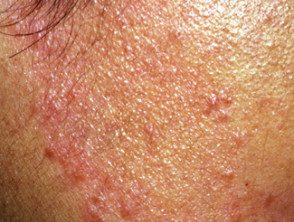
Borderline tuberculoid leprosy
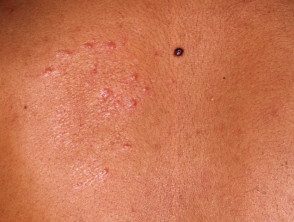
Borderline tuberculoid leprosy
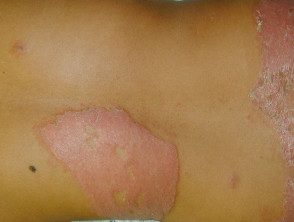
Borderline tuberculoid leprosy with type 1 reaction
The first skin injury It is generally the indeterminate type, causing one or a few hypopigmented spots (pale) before evolving into borderline, tuberculoid or lepromatous types.
Tuberculoid leprosy
- Tuberculoid leprosy can be a large red patch with well defined raised edges or large hypopigmentation asymmetric Stain.
- The lesions become dry and hairless.
- Loss of sensation may occur at the site of some injuries.
- Tender, thickened nerves with subsequent loss of function are common.
- Spontaneous resolution may occur within a few years or may progress to borderline or rarely lepromatous types.
Borderline tuberculoid leprosy
- Borderline tuberculoid leprosy is similar to the tuberculoid type, except that the lesions are smaller and more numerous.
- The disease may remain in this stage or revert to tuberculoid form or progress.
Borderline borderline leprosy
- Borderline leprosy is characterized by numerous red, irregular shapes. plates.
- Sensory loss is moderate.
- The disease can remain in this stage, improve or worsen.
Borderline lepromatous leprosy
- Borderline lepromatous leprosy presents with numerous lesions of all types: plaques, macules, papulesand nodules. Lesions that look like inverted saucers are common.
- Hair Growth and sensation are generally not affected by injuries.
Lepromatous leprosy
- Early nerve involvement in lepromatous leprosy may go unnoticed.
- Numerous lesions of all types, plaques, macules, papules and nodules.
- Early symptoms include nasal congestion, download and bleeding and swelling of the legs and ankles.
If left untreated, the following problems can occur in lepromatous leprosy.
- The skin thickens over the forehead (leonine facies), eyebrows and eyelashes are lost, the nose becomes deformed or collapses, the earlobes thicken, and the upper incisor teeth fall out.
- Causes of ocular involvement photophobia (light sensitivity), glaucoma and blindness
- The skin on the legs thickens and forms. ulcers when the nodules rupture.
- The testicles become wrinkled causing sterility and enlarged (male) breasts.
- Infection of internal organs that causes enlargement of the liver and lymph nodes.
- The voice becomes hoarse due to the participation of the larynx.
- Slow healing of peripheral nerves resulting in nerve thickening and sensory loss.
- Fingers and toes are deformed due to painless repetition trauma.
Lepromatous leprosy
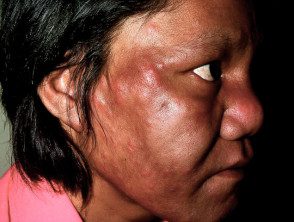
Lepromatous leprosy
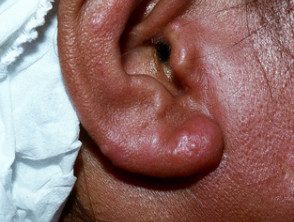
Lepromatous leprosy
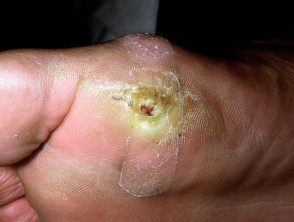
Lepromatous leprosy
How is the diagnosis of leprosy made?
Leprosy has very characteristic clinical features, but the diagnosis must be confirmed due to the need for prolonged antibiotic treatment. A skin biopsy can show features histopathology, with granulomas (mixed inflammatory cell infiltrate In the deeper layers of the skin, dermis) and nerve involvement. Special staining of the tissue may show acid-fast bacilli, the number visible depending on the type of leprosy. Immunohistochemistry Stains may be useful when the bacilli are few.
The bacteria can also be found in lepromatous leprosy in smears taken from skin indentations made in the earlobes, but the smears will be negative in tuberculoid or borderline forms of the disease.
What is the treatment for leprosy?
Leprosy treatment aims to stop the infection and minimize possible physical deformities. First-line antibiotics used to eliminate organisms They include dapsone, rifampin, and clofazimine. Different regimens with multidrug therapy (MDT) are used depending on the type of leprosy and the severity of the infection. This may be a combination of two or three antibiotics given over varying periods of time (up to years). Other antibiotics include minocycline, ofloxacin, and clarithromycin.
The World Health Organization has developed treatment guidelines for leprosy (2018), which recommend three medications, including clofazamine, for 6 months in paucibacillary leprosy and 12 months in multibacillary leprosy.
Oral corticosteroids and thalidomide are useful in preventing nerve damage by reducing swelling. Long courses are necessary to reduce the severity of deformities and disabilities.
Surgery can sometimes be used to drain abscesses to restore nerve function, reconstruct a collapsed nose, or to improve the function or appearance of affected areas.
Patient education is paramount. Leprosy can be cured, but it is essential to take all the medicine. It is no longer infectious once treatment has started. Patients should be instructed on how to treat existing nerve damage, for example, protecting numb feet from injury. Physical, social and psychological rehabilitation is necessary for those in whom the forgotten disease has taken its toll.
Leprosy reactions
Leprosy reactions occur in 30 to 50% of leprosy patients. They may occur earlier or more frequently after the start of treatment and are induced by medications, stress, and surgical procedures. There are 3 main types of reaction.
Leprosy reaction type I (reversal)
The Leprosy type I reaction (reversal) often affects people with a borderline change to the tuberculoid type, as the cell-mediated immune system improves in the first months of drug treatment or for some other reason, such as pregnancy. .
Type 1 reactions result in fever, red inflamed skin and sensitive peripheral nerves. Treatment requires oral corticosteroids and non-steroidal anti-inflammatory drugs.
Leprosy type II reaction
The Leprosy type II reaction is also called erythema leprous nodosum (ENL). It affects people with lepromatous or borderline lepromatous leprosy and is humoral (antibody–antigen) reaction to immune complexes. Repeated episodes tend to occur later in treatment than the type I reaction, usually after several years.
ENL presents as painful red nodules (lumps), which may blister or ulcerate, accompanied by fever, discomfort, joint pain, nerve pain, eye disease and involvement of other organs. Treatment may include clofazimine, thalidomide, corticosteroids, colchicine, cyclosporine, or tumor necrosis factor antagonists.
Pike phenomenon type II
The Lucio phenomenon is a cutaneous vasculitis in patients with lepromatous leprosy. It is difficult to treat and regimens must include MDT.
Lucio phenomenon presents as red patches and irregularly shaped ulcers on the hands, wrists, ankles and feet. It is associated with fever, arthritis, liver and kidney disease.
Leprosy erythema nodosum
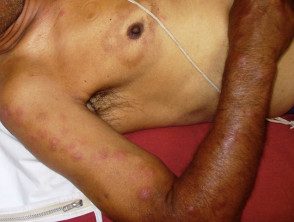
Leprosy erythema nodosum

Leprosy erythema nodosum
Can leprosy be prevented?
People in contact with someone with leprosy can be treated with a single dose of rifampicin during subsequent short-term exposure (2 years). prophylaxis; This reduces the risk of developing paucibacillary leprosy in a 50%.
Research is being done to determine if immunization can be achieved using apathogen, environmental mycobacteria, M. indicus pranii, which may reduce the risk of developing leprosy in at-risk populations, as well as reduce the severity of leprosy in infected people.

